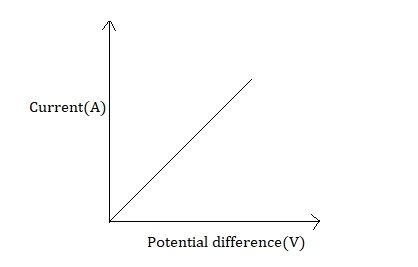
State and prove Ohm’s Law mathematically and graphically
Answer
512.1k+ views
Hint:Current flowing through a conductor is directly proportional to the potential difference across the ends of the conductor provided temperature remains constant. This is the statement of Ohm’s Law.
Formula Used:
We will be using the formula of Ohm’s Law $V = IR$
Complete step by step answer:
Ohm’s Law states that at constant temperature and pressure, the ratio of potential difference (V) between any two points on a conductor to the current (I) flowing through them. It is represented by the symbol $\Omega $.
Mathematically, the current-voltage relationship can be written as,
$\dfrac{V}{I} = $ Constant
Or $\dfrac{V}{I} = R$
Where, V – Potential difference in volts
I – Current in Ampere
R – Resistance of conductor in ohm at the two points. R is constant and is independent of current
Therefore $V = IR$
Thus the resistance or the ratio of voltage to current at a fixed temperature is constant. As voltage increases, current also increases at a constant resistance. In other words by doubling the voltage across a circuit the current will also be doubled.
Graphically, the graph representing the current in X axis and Potential difference in Y axis.

At constant temperature, the current flowing is directly proportional to the voltage across it.
Additional information:
Ohm’s Law only holds true if the provided physical parameters like temperature remain constant. A very good example of Ohm’s Law is the light bulb filament. The light bulb filament in which temperature rises as the current is increased. In this case, Ohm’s Law cannot be applied. The light bulb filament violates Ohm’s Law
Note:Ohm defines the unit of resistance One Ohm is equal to the resistance of a conductor through which a current of one ampere flows when a potential difference of one volt is applied to it.
Formula Used:
We will be using the formula of Ohm’s Law $V = IR$
Complete step by step answer:
Ohm’s Law states that at constant temperature and pressure, the ratio of potential difference (V) between any two points on a conductor to the current (I) flowing through them. It is represented by the symbol $\Omega $.
Mathematically, the current-voltage relationship can be written as,
$\dfrac{V}{I} = $ Constant
Or $\dfrac{V}{I} = R$
Where, V – Potential difference in volts
I – Current in Ampere
R – Resistance of conductor in ohm at the two points. R is constant and is independent of current
Therefore $V = IR$
Thus the resistance or the ratio of voltage to current at a fixed temperature is constant. As voltage increases, current also increases at a constant resistance. In other words by doubling the voltage across a circuit the current will also be doubled.
Graphically, the graph representing the current in X axis and Potential difference in Y axis.

At constant temperature, the current flowing is directly proportional to the voltage across it.
Additional information:
Ohm’s Law only holds true if the provided physical parameters like temperature remain constant. A very good example of Ohm’s Law is the light bulb filament. The light bulb filament in which temperature rises as the current is increased. In this case, Ohm’s Law cannot be applied. The light bulb filament violates Ohm’s Law
Note:Ohm defines the unit of resistance One Ohm is equal to the resistance of a conductor through which a current of one ampere flows when a potential difference of one volt is applied to it.
Recently Updated Pages
Master Class 12 English: Engaging Questions & Answers for Success

Master Class 12 Economics: Engaging Questions & Answers for Success

Master Class 12 Social Science: Engaging Questions & Answers for Success

Master Class 12 Maths: Engaging Questions & Answers for Success

Master Class 12 Chemistry: Engaging Questions & Answers for Success

Master Class 12 Business Studies: Engaging Questions & Answers for Success

Trending doubts
What are the major means of transport Explain each class 12 social science CBSE

Which are the Top 10 Largest Countries of the World?

Draw a labelled sketch of the human eye class 12 physics CBSE

Explain sex determination in humans with line diag class 12 biology CBSE

The pH of the pancreatic juice is A 64 B 86 C 120 D class 12 biology CBSE

Explain sex determination in humans with the help of class 12 biology CBSE




